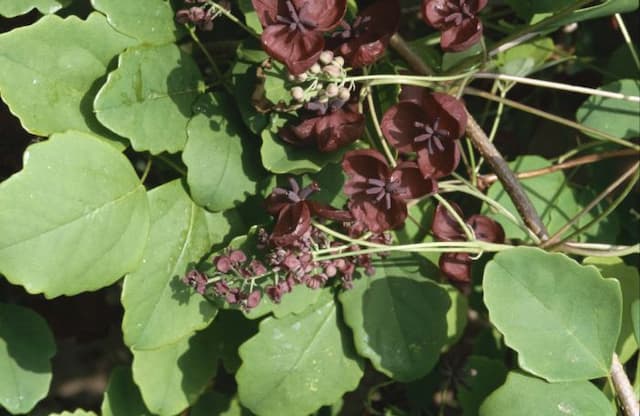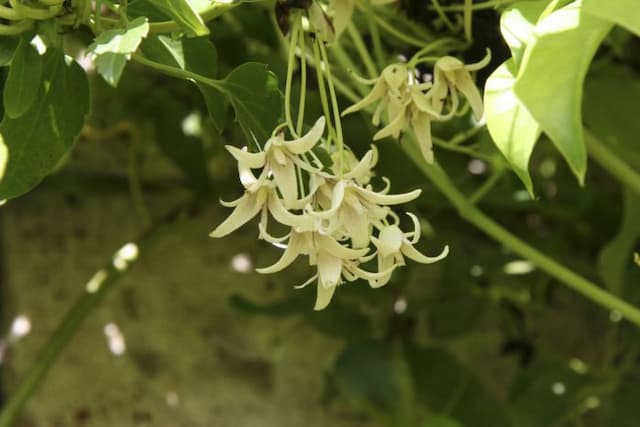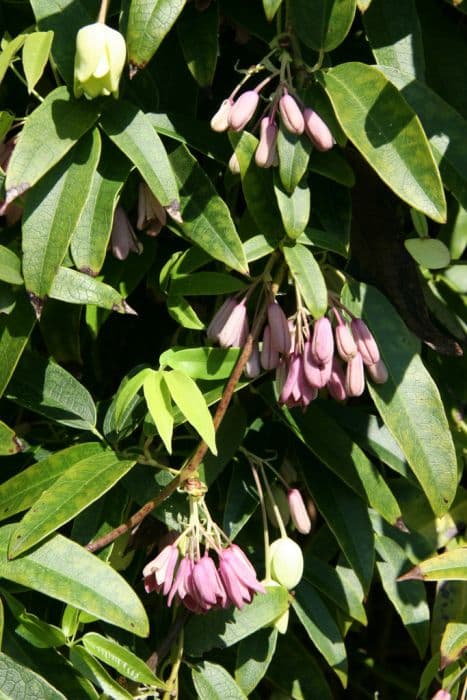Sausage Vine Holboellia coriacea

ABOUT
The plant known as Holboellia coriacea is a vigorous evergreen climber characterized by its lush foliage. It bears thick, leathery leaves that are generally bright green and have a glossy texture, contributing to the plant's robust appearance. Each leaf is divided into several leaflets, which are arranged in a pinnate fashion, meaning they are situated on either side of a central stem. The plant produces highly fragrant flowers, which are often hidden beneath the dense canopy of its leaves. These blossoms are usually purple or lavender in color, adding a subtle splash of color to its surroundings when in bloom. The flowers exhibit a tubular shape and are typically arranged in clusters. Following the flowering season, Holboellia coriacea develops fruit. The fruits are elongated and sausage-shaped, sometimes reaching a notable size, and are initially green, turning to a more purple hue as they mature. The skin of the fruit is smooth, and inside it encases multiple seeds. Overall, the appearance of this plant is typified by its vigorous climbing habit, dense and glossy evergreen leaves, purple flowers with a strong fragrance, and distinctive elongated fruits. It is a plant that can provide year-round interest due to its persistent foliage and seasonal flowering and fruiting characteristics.
About this plant
 Names
NamesFamily
Lardizabalaceae
Synonyms
Sausage Vine, Chinese Sausage Vine
Common names
Stauntonia coriacea, Holboellia latifolia subsp. chartacea, Holboellia latifolia var. chartacea.
 Toxicity
ToxicityTo humans
Holboellia coriacea, commonly known as Sausage Vine, is not widely documented as a toxic plant to humans. However, due to the lack of data, it is recommended to exercise caution and avoid ingesting any part of the plant. If a plant is not well studied, there may be unknown risks associated with its consumption.
To pets
Sausage Vine is not widely reported as being toxic to pets, but as with humans, the absence of confirmed toxicity does not guarantee that it is safe. Without specific information on the toxicity of Holboellia coriacea to pets, it is prudent to prevent pets from ingesting parts of this plant to avoid potential risks. If accidental ingestion occurs, monitoring for any signs of adverse reaction and consulting with a veterinarian would be advisable.
 Characteristics
CharacteristicsLife cycle
Perennials
Foliage type
Evergreen
Color of leaves
Green
Flower color
Purple
Height
20 feet (6 meters)
Spread
20 feet (6 meters)
Plant type
Climber
Hardiness zones
8
Native area
China
Benefits
 General Benefits
General Benefits- Attracts Wildlife: Holboellia coriacea, commonly known as sausage vine, produces flowers that attract pollinators such as bees and butterflies, thereby supporting local ecosystems.
- Aesthetic Appeal: With its lush green foliage and unusual sausage-shaped fruits, sausage vine adds a unique visual interest to gardens or landscapes.
- Fragrance: The flowers of sausage vine emit a pleasant fragrance, contributing to a sensory garden experience.
- Shade Provider: As a vigorous climbing plant, sausage vine can be trained over pergolas or trellises to provide shade in outdoor spaces.
- Screening: Sausage vine can be used to create natural privacy screens, helping to obscure unsightly views with its dense foliage.
- Edible Parts: The fruits of sausage vine are edible, though not commonly consumed; they can offer an exotic addition to the diet where the flavor is appreciated.
- Cultural Significance: In certain cultures, plants like sausage vine may have specific traditional uses or be associated with particular customs or folklore.
 Medical Properties
Medical PropertiesThis plant is not used for medical purposes.
 Air-purifying Qualities
Air-purifying QualitiesThis plant is not specifically known for air purifying qualities.
 Other Uses
Other Uses- Ornamental Climber: Holboellia coriacea, commonly known as sausage vine, is often used as an ornamental plant due to its attractive evergreen foliage and fragrant flowers, making it a popular choice for trellises and arbors.
- Screening Plant: The dense growth habit of sausage vine makes it useful for creating living screens or green walls to provide privacy in gardens and urban spaces.
- Erosion Control: With its vigorous and extensive root system, sausage vine can be planted on slopes to help stabilize the soil and prevent erosion.
- Aromatic Garden Addition: The flowers of sausage vine exude a pleasant fragrance and can be included in sensory gardens or planted near outdoor living areas to add natural scent.
- Shade Provider: When grown over pergolas or patio covers, the thick foliage of sausage vine offers a natural canopy that provides shade during sunny months.
- Habitat for Wildlife: The flowers provide nectar for insects such as bees and butterflies, while the dense foliage offers shelter for birds and small mammals.
- Culinary Decoration: Although not a common use, the unique purple fruit of sausage vine could potentially be used as an exotic decorative element in culinary presentations.
- Foliage for Flower Arrangements: The leaves of sausage vine can be used as a lush green filler in floral arrangements and bouquets.
- Theme Gardens: Due to its Asian origin, sausage vine can be utilized in oriental or Asian-themed gardens to create an authentic ambiance.
- Cultural Symbolism: In some cultures, plants like sausage vine are used in ceremonies or given as gifts due to their beauty and implied meanings such as longevity and perseverance.
Interesting Facts
 Feng Shui
Feng ShuiThe Cathedral Gem is not used in Feng Shui practice.
 Zodiac Sign Compitability
Zodiac Sign CompitabilityThe Cathedral Gem is not used in astrology practice.
 Plant Symbolism
Plant Symbolism- Resilience: Holboellia coriacea, commonly known as Sausage Vine, often symbolizes resilience due to its ability to thrive in a variety of conditions and cling tenaciously to surfaces.
- Growth and Vitality: The vigorous growth of the Sausage Vine embodies vitality and the life force, suggesting an unstoppable energy and zest for life.
- Protection: Its dense foliage, which provides shelter and cover, can symbolize protection and a safe haven.
- Longevity: Given the plant’s long-lived nature, the Sausage Vine can represent longevity and the passage of time.
- Connection: The way it climbs and intertwines with structures and other plants can symbolize human connections and relationships.
 Water
WaterThe Cathedral Gem, as Holboellia coriacea is commonly known, requires consistent moisture to thrive, especially during its growing season in the spring and summer. This plant should be watered thoroughly when the top inch of soil feels dry to the touch, which might be approximately once a week, depending on environmental conditions. On average, use about 1-2 gallons of water for a medium-sized plant to ensure the soil is evenly moist but not waterlogged. During fall and winter, reduce watering frequency to every other week as the plant enters a dormant state and requires less moisture.
 Light
LightThe Cathedral Gem prefers a location with bright, indirect sunlight. It can be placed in an east-facing or north-facing window where it will receive some morning sun but be shielded from the harsh afternoon rays. Direct sunlight should be avoided as it can scorch the leaves of this delicate vine.
 Temperature
TemperatureThe Cathedral Gem can tolerate a range of temperatures, but it grows best at temperatures between 60 and 75 degrees Fahrenheit. It should not be exposed to temperatures below 50 degrees Fahrenheit, as cold drafts and sudden drops in temperature can damage the plant. Ideally, maintain a consistent temperature around the ideal range for the best growth conditions.
 Pruning
PruningThe Cathedral Gem should be pruned to maintain shape, encourage fuller growth, and remove any dead or damaged stems. Pruning is best done in the late winter or early spring before the new growth starts. Depending on the size and desired shape of the plant, prune sparingly to moderately each year, focusing on shaping the vine and sustaining a manageable size.
 Cleaning
CleaningAs needed
 Soil
SoilSausage Vine prefers a rich, well-draining soil mix with a slightly acidic to neutral pH of 6.0 to 7.0. A mix consisting of loam, peat, and coarse sand or perlite in equal parts would be ideal. Regular organic matter additions will promote vigorous growth.
 Repotting
RepottingSausage Vine should be repotted every 2 to 3 years or when it outgrows its current container. Spring is the best time to repot this plant to minimize stress and promote recovery during the growing season.
 Humidity & Misting
Humidity & MistingSausage Vine thrives in moderate to high humidity levels, ideally between 60% to 80%. Maintaining consistent humidity will support the plant's lush foliage and overall health.
 Suitable locations
Suitable locationsIndoor
Provide bright, indirect light and consistent humidity.
Outdoor
Plant in partial shade, shelter from heavy frost.
Hardiness zone
8-10 USDA
 Life cycle
Life cycleThe life cycle of Holboellia coriacea, commonly known as the sausage vine, begins with seed germination, where the seeds require warmth and humidity to sprout roots and shoots. The seedling stage follows, with the development of the first leaves, and establishment of the plant in a suitable growing medium. As it enters the vegetative stage, the sausage vine grows vigorously, producing climbing vines and heart-shaped leaves, with the plant needing support to climb. During the reproductive stage, typically in spring, it produces small, fragrant flowers, which are followed by the development of elongated, sausage-shaped fruits when pollinated. After fruiting, seeds are dispersed to start a new generation, while the parent plant can continue its growth cycle, producing flowers and fruits for many years. Mature Holboellia coriacea may undergo periods of dormancy during colder seasons, shedding leaves and temporarily halting growth, but will resume its active cycle with the return of favorable conditions.
 Propogation
PropogationPropogation time
Spring to Summer
The most popular method of propagation for the Holboellia coriacea, commonly known as the sausage vine, is by semi-hardwood cuttings. Propagation is typically most successful when cuttings are taken in late summer. This involves selecting a healthy, semi-ripe stem from the current year's growth. The cutting should be about 4 to 6 inches (10 to 15 centimeters) long with several leaves. The bottom cut should be made just below a leaf node, and the lower leaves are removed. The cut end is then dipped in rooting hormone to encourage root development and planted in a well-draining soil mix. The cutting should be kept in a warm location with indirect light and maintained moist until roots develop, which can take several weeks.




